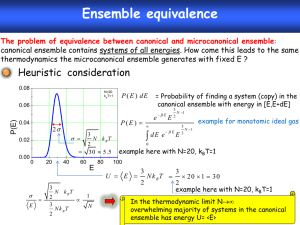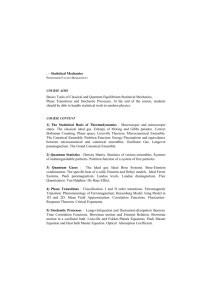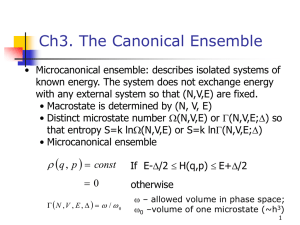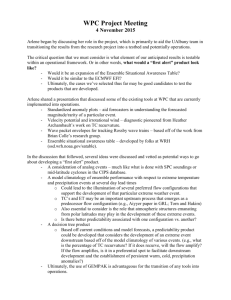The Ensembles
advertisement
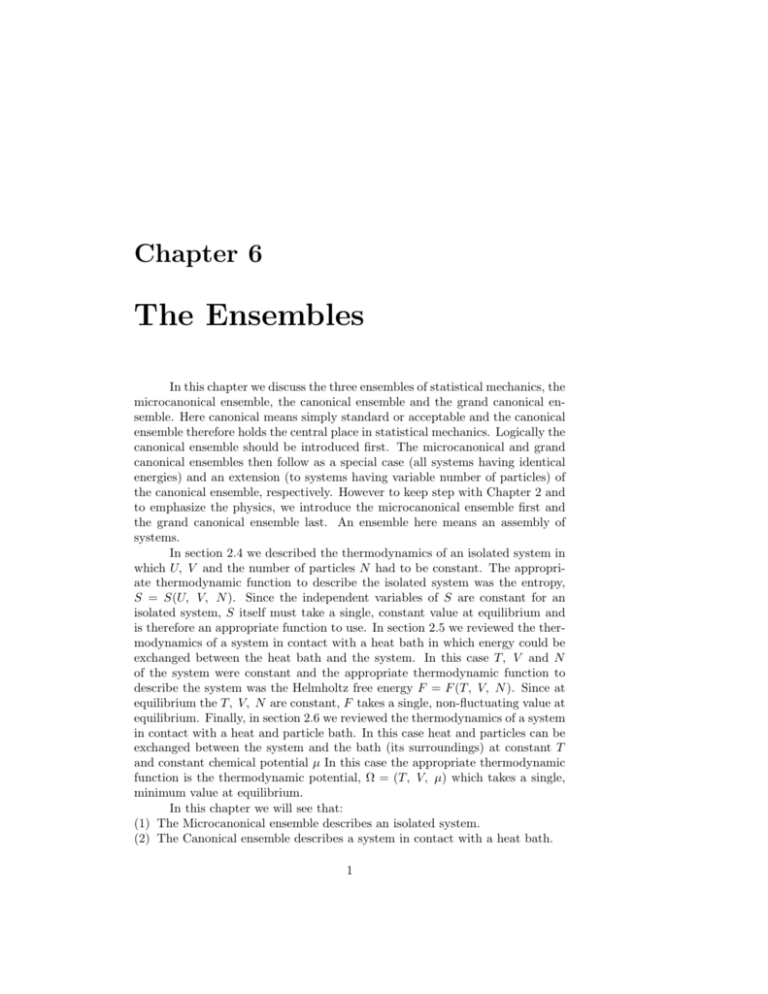
Chapter 6
The Ensembles
In this chapter we discuss the three ensembles of statistical mechanics, the
microcanonical ensemble, the canonical ensemble and the grand canonical ensemble. Here canonical means simply standard or acceptable and the canonical
ensemble therefore holds the central place in statistical mechanics. Logically the
canonical ensemble should be introduced first. The microcanonical and grand
canonical ensembles then follow as a special case (all systems having identical
energies) and an extension (to systems having variable number of particles) of
the canonical ensemble, respectively. However to keep step with Chapter 2 and
to emphasize the physics, we introduce the microcanonical ensemble first and
the grand canonical ensemble last. An ensemble here means an assembly of
systems.
In section 2.4 we described the thermodynamics of an isolated system in
which U, V and the number of particles N had to be constant. The appropriate thermodynamic function to describe the isolated system was the entropy,
S = S(U, V, N ). Since the independent variables of S are constant for an
isolated system, S itself must take a single, constant value at equilibrium and
is therefore an appropriate function to use. In section 2.5 we reviewed the thermodynamics of a system in contact with a heat bath in which energy could be
exchanged between the heat bath and the system. In this case T, V and N
of the system were constant and the appropriate thermodynamic function to
describe the system was the Helmholtz free energy F = F (T, V, N ). Since at
equilibrium the T, V, N are constant, F takes a single, non-fluctuating value at
equilibrium. Finally, in section 2.6 we reviewed the thermodynamics of a system
in contact with a heat and particle bath. In this case heat and particles can be
exchanged between the system and the bath (its surroundings) at constant T
and constant chemical potential µ In this case the appropriate thermodynamic
function is the thermodynamic potential, Ω = (T, V, µ) which takes a single,
minimum value at equilibrium.
In this chapter we will see that:
(1) The Microcanonical ensemble describes an isolated system.
(2) The Canonical ensemble describes a system in contact with a heat bath.
1
2
Statistical Mechanics.
(3) The Grand Canonical ensemble describes a system in contact with a heat
and particle bath.
Thus the appropriate ensemble to use depends upon the physical circumstances.
Also, when there is particle exchange between the system and its surroundings
but the fluctuations from some average value N are vanishingly small, then there
is little difference between the constant N and variable N cases. In this case the
canonical ensemble and grand canonical ensembles would give the same result.
Noticing this it is sometimes convenient, for calculation purposes, to use the
grand canonical ensemble when N is constant and later impose the restriction
that fluctuations from N are insignificant. The appropriate ensemble to use is
therefore also a question of convenience.
Finally, we have already introduced the canonical ensemble in detail in
Chapter 5 in describing Gibbs’ statistical mechanics. Gibbs’ interpretation is
the canonical ensemble method of statistical mechanics. Also, we introduced
the grand canonical ensemble in sections 5.3 and 5.4 to calculate the partition
function for the perfect quantum gases. We did that because it was easier to
evaluate the grand canonical partition function in which N could vary than
to calculate the canonical partition function for fixed N . Thus we have really
already seen most of the physics and mathematics of the ensembles. The purpose
of this chapter is to collect the results in a coherent form and to emphasize the
formal connection between the ensembles themselves and between the ensembles
and thermodynamics.
6.1
The Microcanonical Ensemble
A system (a solid, liquid or a gas) which is completely isolated from its
surroundings has constant energy U and a constant number of particles N . We
will suppose it is also contained at constant volume V . If the system has a
number of different types of particles (a number of components), the number of
each component, N1 , N2 , . . . is also constant. A micro-canonical ensemble is
an assembly of mental copies of this isolated system. Since the energy of each
copy is the same, E = U , the need to consider an ensemble is really superfluous.
One system will do. The microcanonical ensemble is depicted in Fig. 2.1 as a
single system.
Since all the copies have the same energy, U , the probability of observing
the system with energy ES is
PS = constant × δ (ES − U ).
(6.1)
If the quantum energy state U of the system is degenerate with degeneracy W ,
then there are W states having energy U or equivalently W ways of forming the
observed system. Using the equal a priori probability hypothesis and
W
X
S=1
PS = 1,
(6.2)
Chapter 6.
3
we must have
1
.
(6.3)
W
This statistical probability and thermodynamics are related through the
famous Boltzmann relation,
S = k log W
(6.4)
PS =
This could be introduced as a hypothesis but it follows from the relation between
S and PS developed in the next section for the central canonical ensemble. This
is eq. (6.11),
X
S = −k
PS log PS
S
= −k W (
1
1
log
)
W
W
= k log W (U, V, N )
Thus, as expected, the appropriate thermodynamic function is S(U, V, N )
which is a maximum at equilibrium for an isolated system. This also demonstrates that Boltzmann’s relation (eq. 6.4) applies to an isolated system.
An important example of an isolated system that we have already considered was the perfect classical gas of Chapter 3. There we considered a gas at
constant energy and sought the distribution of the individual particles over the
single particle energy or velocity states (the Maxwell-Boltzmann distribution).
We then evaluated the thermodynamic properties of the gas itself and obtained
the Boltzmann relation (eq. 6.4) with
W =
N!
n1 ! n2 ! n3 ! . . .
Here ni is the number of particles in the single particle energy state ²i . The
equilibrium or most probable state of the gas was that for which W was a maximum. Thus the whole gas can be regarded as an example of a microcanonical
ensemble although in Chapter 3 we were more interested in the statistics of the
individual particles.
Since isolated systems are difficult to realize in practice, the microcanonical ensemble is not often used.
6.2
The Canonical Ensemble
We consider now a system (a solid, liquid or a gas) in contact with a heat
bath at constant temperature. A canonical ensemble is an assembly of mental
copies of this system. Since energy can be transferred between the system and
the heat bath, the energy of the systems in the assembly differ. To represent
the possible energy states of the system adequately in the ensemble, we must
4
Statistical Mechanics.
have enough copies that each state is represented at least once in the ensemble.
All copies have the same temperature T , the temperature of the heat bath.
We could imagine constructing the canonical ensemble from the single
system in the microcanonical ensemble of Fig. 2.1 in the following way. We
divide the isolated system in Fig. 2.1 into many (say 109 ) parts. If the original
system contained 1025 particles each part is still large enough to represent the
macroscopic properties of the original system. We take one part as the system
itself and regard the remaining parts as making up the mental copies in the
canonical ensemble. We may also regard the one part as making up the system
and the remaining parts as making up a heat bath. Since the new system is in
good thermal contact with the remaining (surrounding) copies, there is exchange
of heat between system and the heat bath. The exchange of heat serves to keep
the system at constant T .
This canonical ensemble is the Gibbs canonical ensemble we considered in
Chapter 5. Using the Boltzmann combinatorial method to find the probability
of observing the system in energy state ES in this ensemble we found
PS =
where
Z=
1 −βES
e
Z
X
e−βES
(6.5)
(6.6)
S
is the canonical partition function. This partition function is related to the
Helmholtz free energy by
F (T, V, N ) = −kT log Z (T, V, N )
(6.7)
The relations forms the link between the microscopic states ES (V, N ) of the
system and its thermodynamic properties. It also allows us to write PS in the
compact form
PS = eβ(F −ES )
(6.8)
and clearly,
X
PS = 1 .
(6.9)
S
The canonical ensemble is generally the most useful in practice since we
most often deal with systems in thermal equilibrium (constant T ) with their
surroundings. The energy states fluctuate and the probability of observing the
system in a given energy state at constant T is given by eq. (6.5). We also
see that the microcanonical ensemble is a special case of the canonical ensemble in which all the systems have the same energy. Clearly if the energies of
the systems in the canonical ensemble fluctuate little about some mean value,
the canonical and microscopic ensembles will be identical. This √
is always the
case if N is large enough since ∆ERM S /E is proportional to 1/ N . We saw
an example of this in Chapter 5. There the classical gas properties were derived in the canonical ensemble and found identical to those obtained using the
microcanonical ensemble.
Chapter 6.
5
We now develop some useful relations in the canonical ensemble. The
internal energy is
X
U=
PS ES
(6.10)
S
and the entropy is,
S = −k
X
PS log PS .
(6.11)
S
This follows from eq. (6.8) since
log PS = β (F − ES )
and
X
PS log PS =
X
1 X
PS F −
PS ES )
(
kT
S
S
=
S
1
(F − U ) = −S/k
kT
The free energy can be expressed as
X
F = U − TS =
PS (ES + kT log PS )
(6.12)
S
This expression for F is often useful if an approximate value for PS being used.
In Quantum Statistical Mechanics the Boltzmann factor PS is often written as an operator,
ρ̂C = eβ(F −Ĥ)
(6.13)
where H is the Hamiltonian. This follows from the Schrödinger equation,
Ĥ |ES i = ES |ES i ,
(6.14)
so that when the exponential in ρ is expanded as a power series
ρ̂C |ES i = eβ(F −ES ) |ES i .
(6.15)
We may calculate the average value of a property A in the following way. If A
takes on the value AS when the system is in state S, then
 |ES i = AS |ES i
(6.16)
The statistical average of A is
hAi =
X
PS AS
S
=
X
S
hES | PS AS |ES i
(6.17)
6
Statistical Mechanics.
Figure 6.1: Open Sub-system of Na particles in a volume Va .
assuming the eigenstates ES are normalized. Using the operator equations
(6.15) and (6.16) we may write
hAi =
X
hES | ρ̂C Â |ES i
S
≡ Tr
n
o
ρ̂C Â
(6.18)
­ ¯ ®
Here the trace, Tr, is defined as the sum over the states ES ¯ES . The compact
form (eq. 6.18) is often used to represent averages in the canonical ensemble
and ρ̂C in eq. (6.13) is called the canonical density operator.
6.3
The Grand Canonical Ensemble
Here we consider an open system in contact with a heat and particle bath.
The system is open meaning that particles as well as heat can be exchanged
between the bath and the system. An example is a solid or liquid (the system)
in contact with its vapor (the bath) in equilibrium so that particles are freely
exchanged between the liquid and the vapor. Since the vapor and liquid are
in equilibrium, the chemical potential, µ, is the same in each (and particles
are exchanged to maintain µ the same in each phase) The grand canonical
ensemble is an assembly of mental copies of this open system. In the ensemble
all possible states of the system are represented; that is, all possible values of
N and all possible energy states ES (N ) for a given N .
We can construct a grand canonical ensemble from the canonical ensemble
depicted in Fig. 6.1. We sub-divide the closed system having N particles in
Fig. 6.1 into two parts; one small part having Na particles in volume Va and
the second having Nb particles in the remaining volume, Vb . We choose Na ¿
Nb = N − Na . This division is depicted in Fig. 6.1. The small sub-system
is our open system and particles can be freely exchanged between it and the
remaining N − Na particles. The ensemble is then an assembly of mental copies
of this open sub-system.
To develop the statistics for the open system we recall that the probability
of observing the closed system of N particles in energy state ES is from eq. (6.5),
PS = Z −1 e−βES = eβ(F −ES )
Chapter 6.
7
Assuming weak mechanical contact between the sub-system (Na particles) and
the remainder of the system (Nb particles) we can write
ES = ESa (Na ) + ESb (Nb )
and
F (T, V, N ) = Fa (T, Va , Na ) + Fb (T, Vb , Nb )
so that
PS = e−βESa (Na ) × e−βESb (Nb ) × eβF (T, V, N )
The probability PSa (Na ) of observing the sub-system in energy state ESa (Na )
for any given state of the system b is
X
PSa (Na ) =
PS (N ) = e−βESa (Na ) eβ(F −Fb )
Sb
where as usual
Fb = −kT log
X
e−βESb (Nb )
Sb
Since Na ¿ N − Nb we may write
Fa = F − Fb =
³ ∂F ´
∂N
Na +
³ ∂F ´
∂V
Va
= µNa − pa Va
Thus
PSa (Na ) = e−βpa Va e−β(ESa (Na )−µNa )
(6.19)
We have the central result that the probability of observing the open subsystem having Na particles and in energy state ESa (Na ) is proportional to exp
(−β(ES (Na ) − µNa )). We now focus our attention entirely on the sub-system
and drop the subscript a and write this probability as
PS (N ) ∝ e−β(ES (N )−µN )
We also define the grand canonical partition function as in section 5.3 by
X
Z=
e−β(ES (N )−µN )
(6.20)
S,N
Since we want the probability to be normalized so that
X
PS (N ) = 1
(6.21)
S,N
we have, from (6.19) and (6.20),
X
PS (N ) = 1 = e−βP V Z
S,N
(6.22)
8
Statistical Mechanics.
This gives
PS (N ) = Z −1 e−β(ES (N )−µN )
(6.23)
and our relation between thermodynamics and statistics for open systems as
pV = kT log Z (T, V, µ) .
(6.24)
In the thermodynamic summary in Chapter 2 we saw that the thermodynamic potential
Ω (T, V, µ) = F (T, V, N ) − µN
(6.25)
was a constant(a minimum) for an open system in equilibrium with a heat and
particle bath. In this relation µ is
µ=
³ ∂F ´
∂N
T, V
=
³ ∂G ´
∂N
T, P
Also µ is the Gibbs Free energy per particle, G = µN . The thermodynamic
potential is the appropriate function to describe an open system since T, V and
µ are constant so that Ω will be constant while F , for example, can fluctuate
as N fluctuates. The Ω can be directly related to Z using the thermodynamic
relation, G = F + pV so that
Ω = G − pV − µN = −pV
and
Ω = −kT log Z (T, V, µ)
(6.26a)
This can be used as the fundamental relation between statistics and thermodynamics for open systems. It is interesting to note that in going from a closed to
an open system (at constant µ) we transferred from F to Ω using eq. (6.25) in
our thermodynamic summary in Chapter 2. This gave us a function Ω(T, V, µ)
of variables T , V , and µ rather than a function F (T, V, N ) of variables T , V ,
and N . In introducing the grand canonical ensemble we have effectively made
the same transformation of variables by summing over N . That is
Z (T, V, µ) =
XX
N
=
X
e−β(ES (N )−µN )
S
e−βµN Z(T, V, N )
(6.26b)
N
This serves to eliminate the dependence on N and introduce µ.
Using the thermodynamic potential we can obtain some useful relations
for PS (N ), N , U and S. From eq. (6.25)
X
Ω = U − T S − µN =
PS (N ) ES (N ) − T S − µN
S,N
Chapter 6.
9
Hence
PS (N ) =
and
∂Ω
∂
= −β −1
log Z
∂ES (N )
∂ES (N )
µ
N =−
∂Ω
∂µ
¶
= β −1
T,V
∂
(log Z)T,V
∂µ
(6.27)
(6.28)
Also,
X
∂
log Z = −Z −1
(ES (N ) − µN ) e−β(ES (N )−µN )
∂β
S,N
=−
X
PS (N ) ES (N ) + µN
S,N
so that
U =−
∂
(log Z)V, µ + µN
∂β
(6.29)
The entropy is related to the grand canonical probability function PS (N ) in the
same form as eq. (6.11). That is
X
S = −kT
PS (N ) log PS (N ) = −k hlog PS (N )i
(6.30)
S,N
This follows from eqs. (6.23) and (6.26) since
log PS (N ) = − (ES (N ) − µN ) − log Z
and
−β −1
X
PS (N ) log PS (N ) =
S,N
X
PS (N )
£
¤
ES (N ) − µN − Ω
S,N
= U − µN − Ω = T S .
We could also introduce a density operator ρ̂GC for the grand canonical
ensemble in analogy with ρ̂C in eq. (6.13) the canonical ensemble. This is
ρ̂GC = eβΩ e−β(Ĥ−µN̂ )
Average values in the grand canonical ensemble are,
n
o
hAi = Tr ρ̂GC Â
≡
XD
S,N
¯
¯
E
¯
¯
ES (N ) ¯ρ̂GC ¯ ES (N )
(6.31)
(6.32)
10
Statistical Mechanics.
The relation eq. (6.11) and eq. (6.30) can be expressed in terms of ρC and ρGC
as
S = −k Tr {ρC log ρC } = −k Tr {ρGC log ρGC }
(6.33)
Finally, when do we use the grand canonical ensemble? Clearly we use it
to describe open systems where the number of particles is variable. If we have
more than one kind of particle, a multicomponent system, then
PS (N1 , N2 , . . .) = Z −1 e−β(ES −µ1 N1 −µ2 N2 −...)
and
Z=
X
X
e−β(ES −µ1 N1 −µ2 N2 −...)
N1 ,N2 ... S
where N1 and µ1 are the number and chemical potential of type 1 particles and
so on.
We can also use the grand canonical ensemble to describe a closed system
if this is convenient. In section 5.4 we saw that the RMS fluctuation in the
number of particles N about the average value N in an open system is
h
i1
√
2 2
(∆N )RMS ≡ N2 − (N )
∝ N
Thus the fluctuation in the number of particles is
(∆N )RMS
1
∝ √ ,
N
N
which is vanishingly small for a large system of particles(N ∼ 1023 ). This is
generally true for open systems except near a phase transition or a critical point.
With these exceptions there is essentially no difference between an open and a
closed system containing a macroscopically large number of particles. Thus we
could use a grand ensemble to describe a closed system since we can ignore
all the states having N particles different from the average N . This means we
could calculate Z for a closed system pretending N was variable, if that were
convenient, and ignore all the states N 6= N at the end of the calculation. After
Z is obtained, we approximate (6.26b) by
Z(T, V, µ) = e−βµN Z(T, V, N )
(6.34)
to obtain
F = −kT log Z = −kT log Z − µN
and
PS = PS (N ) = −
∂
log Z(T, V, N )
∂ES (N )
for the closed system. This is what we did in section 5.3 for the quantum gases.
Thus the choice of the ensemble is also a matter of convenience.
Chapter 6.
11
We can also use the grand ensemble to describe a closed system in which
all the energy states are fixed at ES = U as well as all N = N in this case Z in
eq. (6.34) reduces to
Z = eβµN
X
e−βES (N )
S
= eβµN e−βU W
where W is the degeneracy of the single energy state. Using eq. (6.26a)
Ω = U − T S − µN = −µN + U − kT log W
and
S = k log W (U, V, N )
Thus we can use the grand ensemble in any case should it be convenient provided
N is large.
